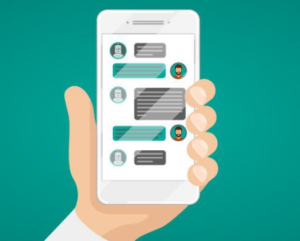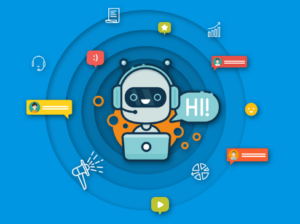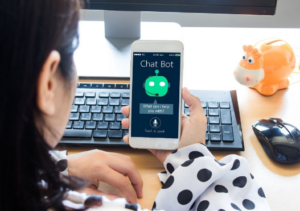If you’ve ever used customer support live chat service, you’ve probably experienced that vague, sneaking suspicion that the “person” you’re chatting with might actually be a robot. That is the way it goes with using chatbots.

Like the endearingly stiff robots we’ve seen in countless movies – tragic, pitiful machines tortured by their emotional range, hoping to attain a greater degree of humanity – chatbots often sound almost human. But not quite.
In this post, we’ll be taking a look at some of the most innovative ways companies are using them. We’ll be exploring why chatbots have become so popular, as well as the wider, often-unspoken impacts these constructs promise to have on how we communicate, do business, and interact..
What Are Chatbots?
A chatbot (also known as a smartbot, conversational bot, chatterbot, interactive agent, conversational interface, Conversational AI, or artificial conversational entity) is a computer program or an artificial intelligence which conducts a conversation via auditory or textual methods.
The term “ChatterBot” was originally coined by Michael Mauldin (creator of the first Verbot, Julia) in 1994 to describe these conversational programs.[2]
Chatbots – also known as “conversational agents” – are software applications that mimic written or spoken human speech for the purposes of simulating a conversation or interaction with a real person. There are two primary ways chatbots are offered to visitors: via web-based applications or standalone apps.
Best Applications
Now that we’ve established what chatbots are, let’s get to their application examples.
Using Chatbots … Casper: Helping Insomniacs
If you suffer from insomnia, as I do, you’ll know that the feeling of almost suffocating loneliness – the idea that everyone else in the world is resting peacefully while your own mind betrays you with worries and doubts – is among the worst parts of not being able to sleep.

Enter Casper’s amazingly named Insomnobot 3000 (which truly is one of the most tongue-in-cheek, retro-futuristic names for a chatbot I’ve ever come across), a conversational agent that aims to give insomniacs someone to talk to while the rest of the world rests easy.
Using Chatbots … Disney: Solving Crimes
Chatbots may be most prevalent in the customer service industry, but that hasn’t stopped major media conglomerate Disney from using the technology to engage younger audiences.
Disney invited fans of
the movie to solve crimes with Lieutenant Judy Hopps, the tenacious, long-eared
protagonist of the movie. Children could help Lt. Hopps investigate mysteries like those in the movie by interacting with the bot, which explored avenues of
inquiry based on user input. Users can make suggestions for Lt. Hopps’
investigations, to which the chatbot would respond.
This is definitely one of the more innovative uses of chatbot technology, and
one we’re likely to see more of in the coming years.
Using Chatbots … MedWhat: Faster Medical Diagnoses
One of my favorite pastimes is radically misdiagnosing myself with life-threatening illnesses on medical websites. If you’re the kind of person who has WebMD bookmarked for similar reasons, it might be worth checking out MedWhat.
This chatbot aims to make medical diagnoses faster, easier, and more transparent for both patients and physicians alike.
MedWhat is powered by a sophisticated machine learning system that offers increasingly accurate responses to user questions based on behaviors that it “learns” by interacting with human beings.
MedWhat is much closer to a virtual assistant (like Google Now) rather than a conversational agent. It also represents an exciting field of chatbot development that pairs intelligent NLP systems with machine learning technology to offer users an accurate and responsive experience.
Unilever: Raising Awareness
Although you may not be familiar with British tea company PG Tips’ brand mascot, Monkey, our British readers will almost undoubtedly recall the brand’s stand-up comedian Johnny Vegas:
What began as a televised ad campaign eventually became a fully interactive chatbot developed for PG Tips’ parent company, Unilever (which also happens to own an alarming number of the most commonly known household brands) by London-based agency Ubisend, which specializes in developing bespoke chatbot applications for brands.
The aim of the bot was to not only raise brand awareness for PG Tips tea but also to raise funds for Red Nose Day through the 1 Million Laughs campaign.

The Value of Chatbots
One way to stay competitive in modern business is to automate as many of your processes as possible. Evidence of this is seen in the rise of self-checkout at grocery stores and ordering kiosks at restaurants.
The value in chatbots comes from their ability to automate conversations throughout your organization.
Below are five key benefits businesses realize when using chatbots.
Save Time & Money
By automating conversations that would otherwise require an employee to answer, organizations save time and money that can then be allocated to other efforts.
Instead of having your reps spending all of their time answering inbound questions, those individuals reallocate time to proactively finding relevant conversations to join with social listening tools.
The amount of time you save increases as your inbound message quantity increases.
And since Sprout Social research shows the number of social messages requiring a response from a brand increased by 18% from 2015 to 2016, you save countless hours by automating responses with a chatbot.
Generate Leads & Revenue
Chatbots use direct messages to gather information necessary to provide effective support. For example, asking users why they’re visiting your page is one question that is likely asked in every engagement.
Automating this initial interaction allows users to share the information needed for the agent to better serve them without requiring a human to ask for it. For example, Drift’s website chatbot qualifies prospects and gathers their email addresses so a sales rep can follow up.
This chatbot automatically delivers qualified leads to the sales organization while also fighting the fatigue caused by answering the same questions over and over. You’ll find the team is happier with more quality leads and time to spend on more meaningful work.
Guide Users to Better Outcomes
Customers don’t always know where to go to find the information they’re interested in. In fact, your customers may not even know what it is they’re interested in. Maybe they just heard your brand name in passing and decided to explore.
By asking a series of qualifying questions, you route users to the best place for them to find the information they want.
Think through some of the questions to ask that will route your visitor to the best possible solution. These questions vary by business type, but some common ones are:
- What problem are you trying to solve?
- What are your goals?
- Where are you located?
- What department are you in?
- What industry are you in?
- Would you like personal support?
This seamless user experience makes the painstaking process of planning a trip much easier for both the user and the business.
Provide ‘After Hours’ Support
As we saw from the Drift data, the most popular use of chatbots is to provide quick answers in an emergency. However, organizations that don’t offer 24-hour support won’t provide answers when the office is closed.
By using a robust chatbot when your business is closed, customers still gain access to the information they need.
This is especially important as consumers expect a quicker response than brands can guarantee. According to Sprout Social’s Q2 2016 Index, customers expect a response between 0-4 hours. However, brands typically take 10 hours to respond.
Chatbots help you significantly decrease the average time to respond, bringing you closer to your customers’ expectations.
Engage Users in a Unique Way
Traditionally, customer questions were routed to businesses via email or the telephone, which made user experiences fairly standard and non-customized. But chatbots offer a new, fun and interactive way to engage with brands.
One great example is Domino’s Pizza’s Twitter. Domino’s allows customers to order pizza by simply sharing an emoji. The Domino’s bots then route those orders and ask additional questions if necessary.
Creating your own chatbots
Eager to start creating your own chatbots? Who wouldn’t be. Once you get beyond the initial fear of letting a bot assist you, the idea of creating and launching your own is exciting. Think of all the time you’ll save for new activities.
We’ll walk you through the most important things to consider and the steps to walk through when getting started.
Define Your Goal & Use Case
With such a wide spectrum of interesting use cases to choose from, it’s tough to nail down a specific goal for chatbots. Spend time doing some discovery at the onset to define your goal and then start to craft your use case.
Are you looking to resolve customer service issues? Promote a new product? Or generate quality leads? In order to find out which use case will be most effective for you, chat with your website and social media teams.
Choose Platforms to Leverage
Your chat conversations will differ based on the pages, networks and channels your programs live on. Consider your options:
- Your website
- Facebook Messenger
- Twitter Direct Message
Someone coming to your homepage is likely more knowledgeable of your products than someone who gets to one of your blog posts, and your bots need to be programmed accordingly.
Build Out Your Content Strategy
Next, figure out what content you’d like customers to engage with throughout the chatbot interaction.
Try starting with FAQs. Think about what questions customers are likely to ask your chatbot, that way you build out the proper flows to guide users to the best possible answer.
Craft Your Bot’s Voice & Personality
If you haven’t yet, now is the time to bring in your creative team. Giving your bot a personality humanizes the experience and more closely aligns the chatbot with your brand.
To let customers know they are talking to a bot, many brands also choose to give their bot a name. This gives them the opportunity to be transparent with customers, while fostering a friendly tone.
Make sure to invite copywriting teams into the process to set clear guidelines and a consistent voice for your chatbot.
Write a Great Opening Message
The welcome message is incredibly important for engaging users and getting them to respond to your bot. The best opening messages we’ve seen are those that are compelling, set expectations and ask questions.
Be Compelling
Just because it’s automated doesn’t mean it has to sound robotic. Refer back to
your bot personality and have fun with your message to get users to engage.
Just make sure to maintain your social brand voice.
Set Expectations
First, let customers know they’re chatting with a bot so they understand
potential conversation limits. Second, let customers know how and when they
will chat with a real person.
Ask Questions
Once you’ve hooked your audience, ask them questions that will keep the
conversation going. Use the important questions you found in step No. 3 to make
sure you’re satiating customer needs.
Start Mapping Customer Journeys
Once you ask the first round of questions, start mapping out what the conversation journey may look like. You can do this with a chat tool like Sprout Social, or if you’re not quite there yet, start with building paths using shapes and arrows in Google Drawings.
This example looks at a fictional restaurant which needs to communicate things like store hours, specials and loyalty programs. Add all of the questions your user may want to ask you as possible replies they can click.
Find the Best Possible Responses
For each of the questions you’ve asked, figure out the best responses users can choose. Create multiple responses for every question that you ask so you’re more likely to satisfy the user’s needs.
Build Out All Conversation Trees
Now for every question you ask, and each response available for the user to choose, you must continue to build out the conversation. Some conversations may stop after one question, and some conversations may span multiple levels.
Spend time making sure that all conversations fully satisfy customer needs. When the conversation gets several layers deep, it may be time to push that user to a live representative. If you ever get lost, you can easily preview the entire chatbot experience in Sprout’s Bot Builder.
Guide Customers to Checkout Using Call-To-Action Buttons
The chatbot interaction culminates with the call to action once a user has responded to all of your questions and is ready to move forward. Your call to action is a button you can add to your chatbot conversation to drive users to a specific goal.
Use call-to-action buttons to lead consumers to a specific product category or page on your website, to share their experience with a friend on social or directly to the checkout page. Your bot can be your most valuable conversion tool by pushing users to their final destination.
Think carefully about where you want your customers to land. This is important because the interaction with your brand could lead to high-value conversions at scale, without any manual sales assistance.
When we continue to interact with the Sprout Social Twitter bot, our social team leverages CTAs to push interested users to the proper pages to find more information.
Test Your Conversations
As you can see, chatbot journeys can quickly become complex maps of conversation. In order to make sure that all users are finding valuable information, and not getting stuck or frustrated with your experience, make sure to test every single possible interaction.
Need some help in capturing more customers from your marketing strategies? Creative ideas to help the differentiation with potential customers? Perhaps have Digital Spark Marketing run a content marketing workshop for your staff?
Call today for a FREE consultation or a FREE quote. Learn about some options to scope your job.
Call Mike at 607-725-8240.
All you get is what you bring to the fight. And that fight gets better every day you learn and apply new ideas.
When things are not what you want them to be, what’s most important is your next step. Call today.
Test. Learn. Improve. Repeat.
Are you devoting enough energy improving your marketing, branding, and advertising?
Do you have a lesson about making your marketing strategy better you can share with this community? Have any questions or comments to add in the section below?
Mike Schoultz is the founder of Digital Spark Marketing, a digital marketing and customer service agency. With 40 years of business experience, he blogs on topics that relate to improving the performance of your business. Find them on G+, Twitter, and LinkedIn.
Digital Spark Marketing will stretch your thinking and your ability to adapt to change. We also provide some fun and inspiration along the way. Call us for a free quote today. You will be amazed how reasonable we will be.
More reading on marketing and advertising from Digital Spark Marketing’s Library:
Guinness Marketing Campaign Shows Their Creativity
Secrets to Share on Lego’s Marketing Campaigns
12 Lessons from Ben and Jerry’s Marketing Strategies
Like this short blog? Follow Digital Spark Marketing on LinkedIn or add us to your circles for 3-4 short, interesting blogs, stories per week.